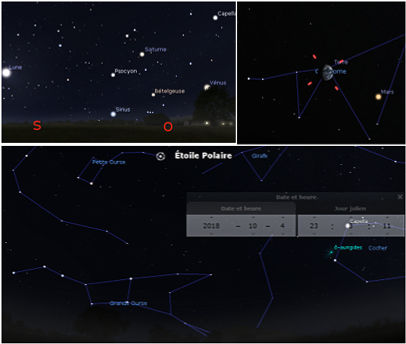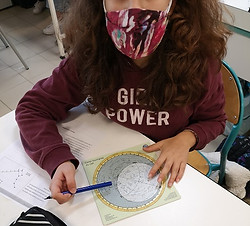France, Montarnaud
September - December 2020
First activity : Dominoes of the solar system
The students began by playing Dominos of the Solar System. This allowed them to become familiar with the planets of our solar system and their characteristics.
Second activity : Escape Game
This puzzle game allows students to discover or rediscover notions about the place of the Earth in the Universe.
A game board is made up of an imposed course of QR-codes. Most of them refer to questions on the theme of astronomy. The answers allow you to unlock the following questions...
Third activity : Introduction to Stellarium
This is free planetarium software for your computer.
It displays a realistic 3D sky, as if you were looking at it with the naked eye,
with binoculars or a telescope.
It allows you to observe the celestial vault at any date and from many observation points on the Earth and even from the Moon, Jupiter and other objects ...
Each pupil was able to discover his or her "birth sky", find the North Star and finally observe the Earth from the Moon.
Fourth activity : Distance units in the universe
In this session we looked at the units of distance in the Universe.
To express distances in the Universe we can no longer use the metre (or the kilometre) as a unit: the numbers obtained would be much too large ....
Imagine: we are in the Milky Way (our galaxy) and the closest galaxy to us is Andromeda. It is about 24,010,000,000,000,000 km away from us, or 2.401 x 1019 km!
1- The Astronomical Unit (AU) :
It is mainly used in the solar system. It is equivalent to the average distance between the Earth and the Sun, i.e. about 150 000 000 km.
1 AU = 150 000 000 km
2- The light year (l.y) :
The light year is used to measure galactic distances.
1 light year (1 l.y) is the distance travelled by light in 1 year.
1 l.y = 9 500 000 000 000 km = 9 500 billion km
Size of our galaxy (the Milky Way): 100,000 al or 1 billion billion km.
Fifth activity : Looking far is looking back
Your big brother has just moved to Australia, he photographs his garden and sends you the photo by post. He doesn't have internet. When you receive your letter, in a few days, it will show you the garden as it was when the photo was taken, not as it is when you receive the letter. You will see the garden in the past. In the meantime leaves may have fallen from the trees ....
Light in space is like the post office! If its speed were infinite, then we would see everything instantly. But that is not the case. It travels at 300,000 km per second in a vacuum.
This is the maximum speed that all forms of matter in the universe can reach.
As a result, the further away something is, the longer it will take for its image to arrive. And this is true for everything, even the Sun. Its light takes about 8 minutes to reach us. So if it were to go out like a lamp now, we would still see it shine for ... 8 minutes.
The closest star to us, after the Sun, is called Proxima Centauri. It is located 4 light years from Earth.
The light it emits, and therefore its image, takes 4 years to reach us. So we see it as it was 4 years ago!
Sixth activity : How to use a rotating map of the sky ?
We learned how to use a rotating map of the sky
- To set the card, simply place the time in front of the date.
Caution: A graduation has been noted on the circumference
of the transparent part every quarter of an hour.
This is the average local solar time. To obtain the time of the watch,
add 1 hour (winter time) or 2 hours (summer time).
- When using the map to observe the sky, you should hold it over your head. It is more comfortable to hold it in front of you, south down when observing south, west down when observing west .
In order to orientate the map correctly, it is important to know where the cardinal points are located.
A well-known star helps us: the North Star (it indicates north!).
Seventh activity : ALBE Association Conference
We had the privilege of welcoming 4 members of the association A.L.B.E (A La Belle Etoile) from Argelliers.
This is an association of passionate amateur astronomers.
The conference was about distances in the universe and the celestial objects that can be photographed.
College Vincent Badie






















